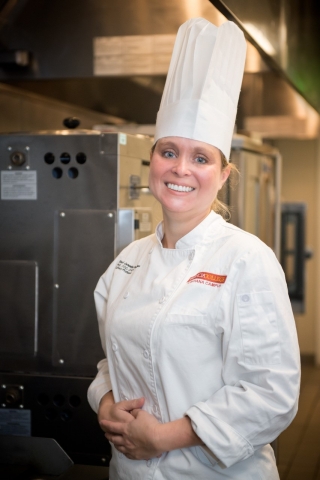
Teaching Perfect Combinations: Butter and Biscuits
28 February 2022Butter as the fat creates better biscuits and helps teach students how and when to bake with butter.
By Dr. Jennifer Denlinger, CCC, CHEP
Feedback & comments: This email address is being protected from spambots. You need JavaScript enabled to view it.
Biscuits from scratch have light layers, absorb butter and have a fantastic flavor. I have eaten homemade biscuits all my life. My grandmother made them so often she memorized the formula. My dad had a delicious recipe too. When I became a culinarian, I wanted to understand the differences between variations in ingredients, even though the basic biscuit recipe is pretty standard. I set out to find a perfect biscuit to add to my repertoire and wondered about the differences between using butter versus shortening and milk versus buttermilk.
I sourced eight recipes and from them created four test recipes. The bottom line is butter and buttermilk are best for biscuits that have a nice flavor and delicious texture. See my chart below.
|
Recipe |
Buttermilk |
AP flour |
BP |
salt |
BS |
sugar |
butter |
milk |
shortening |
notes |
||
|
test 1 |
3 oz |
1 cup |
1.5 tsp |
.5 tsp |
.5 tsp |
1/4 cup |
1/2 stick |
Good for cobbler |
||||
|
test 2 |
1/4 cup |
5 oz BF |
1 tbsp |
.5 tsp |
1 tbsp |
4 tbsp |
||||||
|
test 3 |
1/2 cup |
2 cups BF |
1 tbsp |
1 tsp |
1/4 tsp |
1 tbsp |
4 tbsp |
perfect plus 2 tbsp buttermilk? |
||||
|
Winner |
1.25 cups |
4 cups AP |
2 tbsp |
2 tsp |
1/2 tsp |
2 tbsp |
1 stick |
12-15 biscuits |
egg wash |
½ stick melted |
||
Even though I found my perfect biscuit formula, I have my students use the textbook recipe which is a little more fail-proof. It, too, uses butter and not shortening. This helps indoctrinate students into the biscuit mixing method. They sometimes say, “Wow, these are easier to make than I thought.” I also hear the opposite reaction, “Wow, making a biscuit that looks like yours is harder than what you make it seem.” I also demo a small batch of vegetable shortening biscuits for them to taste the difference. It provides a great opportunity to discuss the difference in texture, price, and when it would be appropriate to use each recipe.
Students also learn about butter during this lesson. I instruct them on the different qualities of butter and show them how to make butter in the stand mixer. I usually reminisce about how in elementary school we made butter by passing around a mason jar of cream and salt with each person shaking it until we got butter.
While their biscuits are baking, I have students do a raw butter tasting. The room-temperature butter is soft and they complete the initial quality taste test. Students sample European butters and compare the flavor to homemade butter and the store-brand butter and write their tasting notes on a sheet that is added to their portfolio. The vegetable shortening demo biscuits can be tasted with butter to make further evaluations.
Another opportunity to taste butter is to flavor it with honey, orange zest or ground cinnamon, which can be made in between the mixing, chilling and resting of the biscuits.
Attachments:
PowerPoint for butter
Butter tasting evaluation sheet
Order for demo and tasting
Chef Jennifer M. Denlinger, PhD., CCC, CHEP, is the Culinary Management Program Department Chair at the Poinciana Campus of Valencia College. She is also the vice president of ACF’s Central Florida Chapter. Additionally, Chef Denlinger earned the 2020 Innovation Award, sponsored by CAFÉ and the Idaho Potato Commission, for a creative escape room based on safe food handling procedures. She also earned the 2021 Green Award sponsored by the United Soybean Board and was runner up in 2021 for the Postsecondary Education of the Year sponsored by Sysco Corporation.
